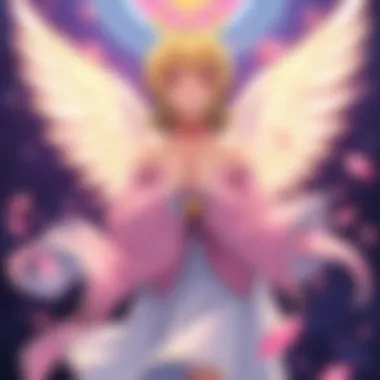Exploring Kamisama Kiss: Themes and Characters Unveiled


Intro
In the vibrant world of anime and manga, few series manage to balance whimsical charm with deep emotional undercurrents. Kamisama Kiss, originally penned by the talented Julietta Suzuki, stands as a testament to this balance. Set against a backdrop rich with Japanese folklore, this series seamlessly intertwines romance, humor, and the supernatural. As viewers delve into the narrative, they are invited to explore not only the enchanting adventures of its characters but also the profound themes that echo throughout the story. This exploration will highlight key elements that make Kamisama Kiss resonate widely with fans around the globe.
Series Overview
Synopsis and Premise
At its core, Kamisama Kiss follows the journey of Nanami Momozono, an ordinary high school girl who finds herself homeless after her father flees from his debts. In an unexpected twist of fate, she stumbles upon a shrine and becomes the new deity, a turn of events that thrusts her into a world filled with spirits, yokai, and divine duties. The premise dances gracefully between the challenges of her new role and her growing relationship with Tomoe, a striking fox familiar who becomes pivotal in her life. The narrative navigates the complexities of love, responsibility, and self-discovery against a backdrop steeped in traditional Japanese mythology.
Notable Characters
Kamisama Kiss boasts a diverse cast of characters that enrich its narrative:
- Nanami Momozono: The earnest protagonist who evolves from a girl devoid of direction to a confident deity embracing her newfound responsibilities.
- Tomoe: The elegant fox familiar, whose initial aloofness gradually morphs into a tender bond with Nanami, embodying both protection and love.
- Mitsuba: A loyal servant who adds depth to the storyline with his own backstory, struggling to find his place in a world of conflicting loyalties.
- Mikage: The former god of the shrine who serves as a mentor figure, granting Nanami wisdom and insights.
These characters are not just plot devices; they encapsulate the emotions and conflicts that make the story so relatable.
Themes and Motifs
Major Themes Explored
In the heart of Kamisama Kiss, several prominent themes emerge:
- Love and Acceptance: The narrative intricately weaves a tapestry of romantic love, platonic relationships, and self-acceptance, emphasizing the importance of sincerity in love.
- Growth and Responsibility: Nanami's transition into a deity symbolizes personal growth—the series deftly explores how responsibilities can lead to stronger character, even in fantastical circumstances.
- Cultural Identity: The has deep roots in Japanese folklore, allowing for a rich exploration of cultural identity as characters interact with various spirits and deities, illuminating cultural beliefs.
Symbolism in Storytelling
Symbolism plays a pivotal role in deepening the narrative. The shrine itself represents a crossroads where the mundane blends with the divine. Each spirit Nanami encounters reflects different aspects of humanity—hope, despair, joy, and sorrow—allowing viewers to connect on a personal level. The fox motif, abundantly present in Japanese culture, symbolizes cunning and protection, resonating with Tomoe's role in Nanami's life.
Artistic Style and Animation
Visual Aesthetics and Design
Visually, Kamisama Kiss captivates viewers with its beautifully detailed character designs and settings. The series fuses vibrant colors with delicate strokes, creating an inviting atmosphere that draws the audience into its magical world. The mix of traditional and modern art styles mirrors the themes of the story, enhancing its cultural resonance.
Animation Techniques and Trends
The animation, produced by TMS Entertainment, effectively utilizes a mix of traditional animation techniques and modern trends. Fluid character movements and lush backgrounds showcase the beauty of the environments, drawing heavily from the landscapes of Japanese culture. Subtle nuances in expressions also help convey deep emotional shifts, turning even a glance into a powerful storyteller.
"The beauty of Kamisama Kiss lies not just in its stunning visuals, but in how it intertwines every design element with its storytelling."
Prelude to Kamisama Kiss
In the landscape of contemporary anime and manga, Kamisama Kiss stands as a beacon of storytelling that weaves together a rich tapestry of emotions, folklore, and character dynamics. This particular series offers much more than just a casual viewing experience; it invites audiences to delve into a world where the boundaries between the human realm and the divine blur. By stepping into the life of Nanami Momozono, the protagonist, we’re not merely observing her journey. We are invited to ponder themes of love, duty, and self-identity that resonate deeply within us all.
One of the critical elements that make Kamisama Kiss relevant to any discussion of modern anime and manga is its ability to fuse traditional elements of Japanese culture with relatable, contemporary challenges. Understanding this series requires a grasp of its backstory and the societal influences that birthed it. It underscores the essence of storytelling in anime, where folklore does not merely serve as a backdrop but as a vital component that influences the progression of characters and plot lines.
As we explore this series, we will dissect how the creator, Julietta Suzuki, ingeniously blends supernatural elements with heartfelt narratives, resonating with viewers on multiple levels. It's a complex exploration of relationships—be it romantic love, friendships, or familial bonds—and with each turn of the page or scene change in the anime, we witness a multi-layered understanding of what it means to connect with others.
There’s also the undeniable layer of humor and emotion that plays a significant role. As the story unfurls, comedic moments are juxtaposed with heavy themes of loneliness and self-doubt, presenting a unique tonal balance that keeps audiences both engaged and introspective.
Overall, the discussion of Kamisama Kiss extends beyond just the characters and plot: it encourages a broader contemplation about cultural identity and individual growth. Through this examination, we aim to illuminate the multidimensional aspects that make Kamisama Kiss noteworthy—not only to anime and manga enthusiasts but to anyone willing to see beyond the surface.
"Kamisama Kiss elegantly combines tragedy, humor, and a celebration of life's simplest joys, reminding us that the journey of self-discovery can be as magical as any folklore we’ve ever known."
In the following sections, we will dive deep into its origins, themes, characters, and the stylistic nuances that contribute to its impact in the anime and manga realms.
The Origins of Kamisama Kiss


Understanding the roots of Kamisama Kiss is crucial to appreciating its overall narrative and themes. The series didn’t just spring forth out of thin air; it is a product of cultural trends, artistic influence, and personal touch. This section delves into its genesis, shedding light on how its creation and historical context shaped it into the beloved series it is today.
Creation and Publishing History
Kamisama Kiss began its life in Hana to Yume magazine, a publication well-known for its shoujo manga content. Created by the talented Julietta Suzuki, this story first graced the pages in 2008. Suzuki’s approach to storytelling, combining elements of romance with fantasy, struck a chord with readers. The illustrations, vibrant yet thoughtful, captured not just the essence of the characters but also the emotional undertones of the plot.
The serialized nature allowed Suzuki to build the lore and character arcs gradually, making each chapter a piece of a larger puzzle. Initially, it comprised a standalone manga that quickly gained traction. By 2011, its popularity led to an anime adaptation, which was met with high hopes and eager anticipation. The transition from manga to anime can be rocky, often losing nuances along the way. However, in this case, the animation kept much of the original spirit. Viewers, familiar with the manga, welcomed the anime with open arms, appreciating how it managed to portray the complex relationships and rich storytelling that fans had come to love.
Cultural Context of the Series
Kamisama Kiss isn't just a story about a girl becoming a deity; it also reflects the cultural milieu of its time. Released in the late 2000s, Japan was experiencing a resurgence of interest in shoujo stories that explored the mystical and fantastical. The blend of folklore and modernity resonated with young audiences seeking escapism mixed with relatable themes of love, identity, and self-discovery.
Moreover, the themes of Kamisama Kiss coincide with Japan’s increasing global outreach in its pop culture, especially in anime and manga. Influences from traditional Japanese folklore can be seen throughout the series. Deities, spirits, and the dichotomy of human and supernatural worlds showcase Japan’s rich history of storytelling. As readers and viewers encounter the characters’ struggles and growth, it parallels their own journeys of understanding their roles in society.
The fusion of traditional themes with modern narratives provides a cultural commentary that resonates even today.
In summary, the origins of Kamisama Kiss present a fascinating blend of personal talent, cultural influences, and societal trends that all contributed to its lasting impact. Understanding these facets not only enhances the appreciation of the series but also provides insight into the broader landscape of contemporary shoujo manga.
Plot Overview
In any story, particularly in a series like Kamisama Kiss, the plot serves as the backbone, weaving together the themes and character arcs into a cohesive narrative. The importance of the plot overview cannot be overstated; it allows readers and viewers to contextualize characters and themes while highlighting key events that shape the protagonist's journey. By examining the structure of the story, we can better appreciate the intricate layers that make Kamisama Kiss a beloved series among anime and manga fans.
Initial Setup and Key Events
Kamisama Kiss begins with a rather unique twist: Nanami Momozono, an ordinary high school girl, finds herself homeless after her father leaves and financial issues come to a head. This initial setup is both relatable and compelling, as it grounds Nanami in reality while introducing an element of fantasy. Her encounter with a mysterious man named Mikage results in her becoming a land god, an unusual role for someone who feels like the rug has been pulled out from under her.
The series escalates as Nanami meets Tomoe, her complex familiar, who initially harbors resentment toward her due to her amateur status as a deity. Key events unfold, such as their blossoming relationship amidst challenges like other gods, spirits, and the looming threat of Nanami being unfit for her role.
- Key Events:
- Nanami's encounter with the man who gives her a new destiny.
- The friction-filled relationship between Nanami and Tomoe, which evolves through trials and tribulations.
- Various supernatural encounters that illuminate the themes of love, responsibility, and self-discovery.
These elements are pivotal, as they set the stage for Nanami's growth and the thematic exploration of love and self-acceptance throughout the series. Moreover, they reflect broader social issues, including the transition into adulthood and facing adversity with courage and resilience. In essence, the plot serves not just as a sequence of events but as a vehicle for thematic depth and character progression.
Character Intros and Dynamics
Character dynamics in Kamisama Kiss play a crucial role in enriching the narrative. Each character is meticulously crafted, with their own desires, flaws, and philosophies that influence their interactions and relationships with others.
- Nanami Momozono: The heart of the story, she embodies growth as she transforms from a lost girl into someone who takes her role as a deity seriously. Her vulnerabilities make her relatable, and her strength inspires those around her.
- Tomoe: Initially aloof but rapidly becomes a pivotal figure in Nanami's journey. His characterization is layered, oscillating between stoic protectiveness and deep-seated emotional turmoil, which adds complexity to their partnership.
- Supporting Characters: Each supporting character brings something essential to the narrative. From Mizuki, the playful yet adoring spirit, to other gods who challenge Nanami's authority and capability, their dynamics serve to highlight the struggles and triumphs within this fantastical realm.
As these characters interact, the viewer witnesses the development of relationships that mirror real-life complexities, further grounding the series in relatable experiences despite its extraordinary premise. The gradual bonding of Nanami and Tomoe amidst conflicts is not just a mere romantic subplot but also a deep exploration of trust, understanding, and emotional healing, addressing how relationships often encounter obstacles but can grow through them.
Character Analysis
The realm of Kamisama Kiss teems with vibrant personalities and intricate relationships, each character distinctly crafted to contribute to the overall narrative. Character analysis is crucial not merely for understanding the surface-level traits of these figures, but for grasping the deeper thematic resonances they emit throughout the story. By dissecting the characters, readers can unearth the layers of intention behind their actions, their relationships, and how these intertwine with the larger context of the story.
The exploration here will delve into the transformations, motivations, and arcs of key characters, shedding light on the complexities that make them relatable and memorable. This analysis empowers readers to connect with the narrative on a more personal level and enables a comprehensive appreciation of the development within the series.
Nanami Momozono: The Evolving Protagonist
Nanami Momozono stands at the forefront as the Kamisama Kiss protagonist, evolving from an ordinary girl into a deity of sorts throughout her journey. Initially grappling with personal challenges like abandonment and self-doubt, Nanami embodies resilience.
Her growth is notable; she transitions from a shy and insecure girl to someone who embraces her role as a shrine god. This change reflects not just external circumstances but internal fortitude, suggesting the theme of self-empowerment. For instance, her determination to save her shrine from decay mirrors her growth as she learns to accept her responsibilities.
Furthermore, her relationships, especially with Tomoe, showcase her emotional evolution. The familial bonds she forges throughout the series reveal her capacity for devotion and love, adding richness to her character.
In Nanami, we find a compelling representation of overcoming adversity and finding strength in oneself, an aspect that resonates well with audiences.
Tomoe: The Complex Familiar
Tomoe, as Nanami's familiar, invites layers of complexity into the narrative. As a fox yokai, he possesses a unique blend of loyalty, aloofness, and hidden vulnerability. Initially appearing as a typical stoic character, Tomoe soon reveals a depth that invites nuanced exploration.


His loyalty is not given unconditionally; instead, it develops as he grapples with his feelings toward Nanami. The struggle between his duty as a yokai and the emergent romantic feelings for Nanami introduces a riveting tension. This duality of role—servant and lover—complicates his character arc, suggesting themes of sacrifice and love.
Tomoe's backstory, intertwined with loss and past relationships, provides insight that explains his hesitance and commitment issues. As his feelings deepen, viewers witness a shift; he transforms from a detached guardian to a supportive partner. Ultimately, his evolution illustrates the significance of vulnerability in love.
Supporting Characters and Their Roles
The supporting cast of Kamisama Kiss plays an equally essential part in enriching the narrative. Characters like Mizuki and Nanami’s friends inject humor, wisdom, and perspective.
- Mizuki, the playful and often annoying snake familiar, offers a lighter tone. His antics punctuate the series with comic relief, contrasting the heavier themes of love and responsibility.
- The other gods and supernatural beings add depth to the story, illustrating varying values and dilemmas faced in the divine realm. This dynamic opens discussions about conflicting ideologies regarding duty and desire.
Moreover, supporting characters often highlight the principal characters' traits by serving as foils. For example, the contrasting relationship dynamics among the characters provide insight into Nanami and Tomoe’s bond.
Themes Explored in Kamisama Kiss
In any narrative, themes act like the unseen thread weaving together its many elements. Kamisama Kiss is no exception, shining a spotlight on core aspects that resonate deeply with viewers. Themes like love, relationships, and personal growth not only enhance character development but also elevate the story, making it relatable and memorable. These threads are what keep the audience engaged, allowing them to reflect on their own experiences through the lens of Nanami Momozono and her fellow characters.
Love and Relationships
At the heart of Kamisama Kiss lies the concept of love in its myriad forms. The series does not shy away from exploring complex relationships, particularly that between Nanami and Tomoe. Their dynamic starts off rocky; Tomoe is, after all, a creature of the supernatural tasked with serving a human. But as the plot unfolds, it is fascinating to watch their relationship evolve. Strategies of love are not merely romantic; they also delve into sacred friendships and familial bonds. This multi-layered approach enables the audience to witness love in its many guises—be it the playful banter between side characters or the deeply emotional connections that shape one's identity.
"Love in Kamisama Kiss transcends mere attraction, it becomes a transformative force driving characters toward growth."
In contrast to the lighthearted moments, the series brings darker themes of loss and longing into play. Characters grapple with their past and their relationships, showing that love is not always a smooth journey. Instead, it presents challenges that foster understanding, courage, and resilience.
The Blend of Comedy and Drama
Narrative balance is crucial in storytelling, and Kamisama Kiss achieves it through an artful blend of comedy and drama. The series utilizes humor to break tension, providing relief even amid emotional turmoil. Elements of comedy are often woven into character interactions; for instance, Tomoe's teasing demeanor lightens the atmosphere, bridging moments of seriousness with humor.
However, the backdrop of drama adds weight to this comedic relief. By alternating between laughter and tears, the story depicts the dualities of life—a feature that enhances its realism. Not every moment is lighthearted, and this mix allows for a fuller exploration of themes. Through ups and downs, viewers are invited to reflect on their life experiences, solidifying the bond with the characters.
Self-Discovery and Growth
Another cornerstone theme in Kamisama Kiss is the journey of self-discovery, particularly embodied in Nanami. Amid the trials she faces as a new deity and her growing responsibilities, she learns not just about her role, but also about herself. The series skillfully illustrates that personal growth is often accompanied by uncertainty and struggle.
For Nanami, each challenge she encounters offers valuable lessons that contribute to her character’s evolution. This theme strikes a chord, as many viewers can relate to the feeling of being out of their depth while navigating life’s hurdles. It reminds the audience that the path to self-acceptance is rarely a straightforward one; it’s littered with setbacks, yet punctuated by moments of triumph.
Art Style and Animation
Art style and animation are paramount in the world of manga and anime, creating not just a visual feast but defining the very heartbeat of storytelling. In Kamisama Kiss, the artistic presentation complements and enhances the narrative, drawing viewers and readers into a rich tapestry of emotions and experiences. The aesthetic choices shape character expressions, setting tone, and immerse the audience in a world where manga meets the divine.
Illustration Techniques in the Manga
The manga iteration of Kamisama Kiss relies heavily on traditional illustration techniques that highlight both character and environment. The line work is distinctive, combining fine details with bold strokes. This contrast helps emphasize the characters' emotional states. For instance, Nanami’s expressions range from whimsical to solemn, and the illustrations encapsulate this journey without the need for words.
- Use of Soft Colors: A palette of soft pastels often conveys the gentle, romantic undertones of the story. This color choice creates an inviting atmosphere that contrasts with the more intense scenes, providing an emotional balance.
- Character Design: Each character is uniquely crafted, with small details that convey their personalities. Tomoe, for example, is depicted with sharp features and an intense gaze, reflecting his complex nature.
In addition, background illustrations play a crucial role in establishing context. The settings are richly detailed, immersing readers in the varied locales, from serene shrines to urban landscapes. The attention to detail in these environments not only enriches the visual storytelling but also deepens the thematic impact of scenes where the characters experience pivotal moments.
Animation Style in the Adaptation
Transitioning from page to screen, the adaptation of Kamisama Kiss retains the manga's charm while introducing fluidity that animation uniquely offers. The animation style is vibrant and dynamic, effectively bringing Tsubaki’s artistry to life.
- Fluid Movements: The animation captures subtleties in character movements, making scenes feel alive. For example, when Nanami interacts with spirits or experiences bouts of comedy, the animators use exaggerated expressions and motions that play up the humor to great effect.
- Visual Effects: Given its supernatural elements, the series employs visual effects to enhance interactions with the spirit world. Ethereal lights and enchanting movement patterns accompany magical moments, creating a sense of wonder and awe.
- Voice Acting Synergy: The anime's voice casting complements the animation style, giving life to the characters in ways that visual art alone cannot. The intonations and emotions conveyed through voice acting deepen the connection viewers feel with the characters, elevating the overall experience.
Overall, the art style and animation in Kamisama Kiss are not mere decoration; they serve as critical tools for storytelling, helping convey themes of love, growth, and the intertwining of two worlds. The overall package ensures that audiences remain engaged from start to finish.
For further insights into anime artistry, references on illustration techniques can be found on platforms like Wikipedia and detailed analysis on Britannica. Consider exploring community discussions on Reddit for fan interpretations and additional perspectives.
Kamisama Kiss: Reception and Impact
The reception of Kamisama Kiss has been as multifaceted as its characters. From its initial serialization to a rich tapestry of adaptations, the series has left a mark not just on its audience but also on the broader landscape of anime and manga. Understanding the impact of this series involves looking at how it has resonated with fans and its significance within the context of popular culture. Key elements such as critical acclaim and cultural legacy play vital roles in drawing in viewers and readers alike.


Critical Acclaim and Audience Feedback
Kamisama Kiss was graced with widespread acclaim soon after launching. Critics appreciated the blend of humor, romance, and supernatural elements, praising its fluid storytelling that felt as much like a dream as it did a compelling narrative. The engaging character arcs of Nanami and Tomoe, in particular, drew attention. Viewers often found themselves entangled in their relationship dynamic, struck by how it reflected personal growth and resiliency.
Audience feedback mirrored this sentiment. Viewers often expressed their heartfelt connection to the characters. Forums and fan sites danced with vibrant discussions, highlighting how Kamisama Kiss captured the essence of youthful love and self-discovery. Many fans noted that the series evoked nostalgia, reminding them of their own experiences growing up, showcasing a skillful melding of fantasy with relatable themes.
- Key Points from Audience Reviews:
- The depiction of Nanami's growth resonated deeply with fans, serving as inspiration.
- Tomoe's complexities added layers to his character, making him memorable.
- Visual artistry and character design received commendations for their vibrancy and expressiveness.
"Kamisama Kiss is a breath of fresh air; it offers a delightful escape into a world where love and destiny intertwine beautifully."
— Anime Enthusiast Review
Cultural Influence and Legacy
The cultural influence of Kamisama Kiss stretches far beyond its storyline. It has sparked a resurgence of interest in shoujo manga, particularly among younger audiences. The series has often acted as a gateway for newcomers to explore the broader genre, effectively bridging gaps between different age groups and preferences within manga and anime enthusiasts.
Beyond entertainment, the themes present have encouraged discussions about agency, personal choice, and the pursuit of one's desires, especially in a societal context where these conversations are increasingly vital. References in memes, fan art, and cosplays paint a picture of how much Kamisama Kiss has seeped into the everyday lives of its fans.
In a nutshell, the legacy of Kamisama Kiss lies not just in its popularity but also in its ability to inspire and resonate across different cultures. It has led the way for future stories to integrate romance, humor, and supernatural themes in a way that encourages a more inclusive and open dialogue among audiences.
- Notable Cultural Impact Points:
- Reinforced the popularity of shoujo elements in contemporary anime.
- Encouraged diversity in character representation within relationships.
- Highlighted the importance of personal growth and self-acceptance.
The enduring appeal of Kamisama Kiss illustrates how a well-narrated story, combined with relatable characters and themes, can touch lives, inspire creativity, and build communities around shared experiences.
Culmination
In wrapping up our exploration of Kamisama Kiss, it becomes clear that this series is more than just a light-hearted blend of romance and supernatural hijinks. Rather, it presents a rich tapestry of themes that resonate deeply with its audience, offering lessons in love, friendship, and self-acceptance. Throughout the journey, both the manga and anime adaptations provide not only an entertaining narrative but also a source of reflection on personal growth.
The characters, particularly Nanami and Tomoe, serve as vessels through which complex themes of identity and transformation are conveyed. They are not just defined by their roles but by their experiences and growth throughout the series. For instance, Nanami's evolution from a lost girl to a confident deity encapsulates the universal struggles many face, making her journey relatable.
"Kamisama Kiss highlights the importance of understanding oneself while navigating relationships with others."
Furthermore, the series adeptly balances comedy with poignant moments of introspection. This blend ensures that while audiences might chuckle at the antics of the divine and less-than-divine characters, they are also prompted to think about the underlying messages these experiences convey.
Moreover, the cultural influence of Kamisama Kiss is noteworthy. It reinforces traditional Japanese beliefs about deities while embedding these within modern narratives, bridging the gap between old and new. The series encourages viewers and readers alike to explore cultural narratives through the lens of personal experiences, which is a compelling aspect of its appeal.
Further Reading and Recommendations
For those wanting to dive deeper into similar narratives or explore themes akin to those presented in Kamisama Kiss, here are a couple of resources:
- Mythical Creatures in Japanese Folklore - A comprehensive guide to the fabulous deities and spirits that appear in various media.
- The Art of Storytelling in Manga - An analysis of storytelling techniques used in manga and their cultural significance.
Further Reading and Recommendations
In delving into Kamisama Kiss, a rich tapestry of themes and characters awaits discovery. For those who feel captivated by the emotional arcs and cultural nuances within the series, seeking further reading and recommendations proves essential. Doing so allows fans to broaden their horizons beyond this one anime and manga universe, paving the way to better understand the context in which such stories thrive. The benefits of exploring similar series or supplemental resources are manifold, enhancing both appreciation and critique of the genres.
Similar Series to Explore
When looking to quench your thirst for storytelling akin to Kamisama Kiss, you might find the following series intriguing:
- Fruits Basket: Much like Kamisama Kiss, this series dives into the lives of characters affected by their supernatural curse and weaves emotional depth with elements of romance and humor.
- InuYasha: Featuring a feisty female lead who is thrown into a fantastical world, this series mirrors the blend of action, romance, and comedy, making it a staple in the fantasy genre.
- Natsume's Book of Friends: This story captivates viewers with the connection between the human realm and spirits. It also explores friendship and loneliness while offering a soothing narrative style.
- Mushishi: For those keen on more mystical undertones, Mushishi presents a slow-paced, reflective journey through nature and the supernatural, rich in folklore and beauty.
- Kamisama Dolls: For a darker tone, this series navigates the tensions arising from the use of powerful, supernatural dolls, appealing to viewers who enjoy a more intense plot.
Each of these selections offers diverse takes on similar themes, refreshing already intricate storytelling.
Additional Resources on Kamisama Kiss
For readers looking to deepen their understanding of Kamisama Kiss, several resources can provide valuable insight:
- Kamisama Kiss Wiki: An extensive repository of information, this wiki offers character descriptions, plot summaries, and analysis of themes, proving useful for newcomers and seasoned fans alike.
- MyAnimeList: This platform provides rankings and reviews that shed light on viewer perceptions and critiques, helping you gauge the anime's reception among audiences globally.
- Reddit Discussions: Engaging in discussions with fellow enthusiasts on platforms like Reddit can expose different viewpoints and interpretations of character motivations and relationships.
"Exploring multiple perspectives and interpretations enhances the enjoyment and understanding of a series."
- Manga & Anime Reviews on YouTube: Channels featuring in-depth reviews can highlight some overlooked facets or critiques, which can reshape one's view or appreciation of the series.
These additional resources foster a community of shared experiences and deeper interpretations, ensuring a fuller grasp of Kamisama Kiss and its place within the wider landscape of anime and manga.



